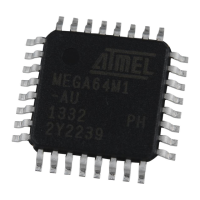89
7647H–AVR–03/12
Atmel ATmega16/32/64/M1/C1
• Bit6 – ICPSEL1: Timer 1 Input Capture selection
Timer 1 capture function has two possible inputs ICP1A (PD4) and ICP1B (PC3). The selection
is made thanks to ICPSEL1 bit as described in Table 11-1.
• Bit 0 – PSRSYNC: Prescaler Reset
When this bit is one, Timer/Counter1 and Timer/Counter0 prescaler will be Reset. This bit is nor-
mally cleared immediately by hardware, except if the TSM bit is set. Note that Timer/Counter1
and Timer/Counter0 share the same prescaler and a reset of this prescaler will affect both
timers.
Table 11-1. ICPSEL1
ICPSEL1 Description
0 Select ICP1A as trigger for timer 1 input capture
1 Select ICP1B as trigger for timer 1 input capture

